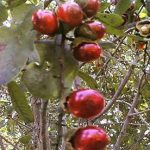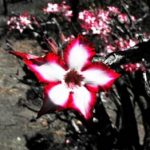TREE LIFE
May 2013
MASHONALAND CALENDAR
Saturday May 4th: Botanic Gardens walk with Tom Muller. Meet at 10.45am in the car park of the Botanic Gardens.
Sunday May 19th: Tree Society AGM
The Tree Society’s Annual General Meeting will be held at the Mukuvisi Woodland Education Centre. We will meet at 9:30 am and tea will be served. It would be greatly appreciated if members could bring a plate of snacks. This will be followed by the AGM itself.
After the meeting, Meg Coates Palgrave will do a short talk about the Tree Society visit to Catapu in April 2012. If there is time we will have a walk in the Woodlands and at lunch time we will have a braai. Please bring your meat, drinks, cutlery, plates and chairs and anything else you might need.
Saturday May 25th: Our 4th Saturday outing May will be to the home of Rob and Sheila Jarvis at 2, Rockyvale Close. Members may remember that this is where we viewed chameleons at the beginning of February this year. We will meet at 14.30.
Reminder: Annual General Meeting of the Tree Society, Sun. 19tH May
AGENDA
- Notice convening the meeting.
- Apologies.
- Minutes of the 62nd A.G.M.
- Matters Arising.
- Chairman’s Report.
- Treasurer’s Report.
- Election of Committee Members.
- Proposed amendments to the Constitution
- Any Other Business.
Please remember that you will need to have paid your subs before the meeting if you wish to vote. – Ed.
SUBSCRIPTIONS
This is a reminder that subscriptions are now due for the period from 1 April 2013 to 31 March 2014. The amount remains US$5.
Payment may be made in various ways:
- By deposit direct to our CABS account number: 901-522-4328. This is the preferred method. The account name is “W.R. Clarke a/c Tree Society”. If you do make a deposit to CABS, please make sure your name is reflected as a reference, and also advise the Treasurer (wrc@mweb.co.zw) by email of the date of your deposit.
- In person to the Treasurer, Bill Clarke at Val D’Or, near Arcturus; or to the Chairman, Mark Hyde (29, Harry Pichanick Drive, Alexandra Park, Harare; tel: Harare 745263; email: mahyde@gmail.com; or to any Tree Society Committee member.
- Payments can also be accepted at our outings.
– Mark Hyde
CHAIRMAN’S REPORT 2012-13 FOR THE AGM ON SUNDAY 19 MAY 2013
I have pleasure in presenting the Chairman’s report for the year 1 April 2012 to 31 March 2013.
General: This is my twelfth annual report as Chairman. The period under review was a busy and successful year for the Tree Society.
Outings: The normal Tree Society series of monthly outings continued and we managed to organise nine 3rd Sunday outings; in the other 3 months there were longer outings in two cases and the third was Tom’s 80th birthday lunch. My 4th Saturday walks continued and these were held in 7 out of the 12 months of the period. In December 2012, Tom’s walks in the Botanic Garden were resumed. After the first few were affected by rain these have got going nicely.
The outings are summarised in the following table:
| Month | Main outing | 4th Saturday |
| April 2012 | Jacana Yacht Club | – |
| May | AGM, Mukuvisi Woodlands | Peggy Sheppard’s garden |
| June | Bill Bedford’s game park | National Botanic Garden |
| July | Lanark Game Park | – |
| Month | Main outing | 4th Saturday |
| August | Mharapara Farm | – |
| September | (Hippo Pools) | Chenaux-Repond, Sentosa |
| October | (Tom’s 80th birthday) | Dave Hartung’s garden |
| November | Christon Bank | – |
| December | Christmas Social, Mukuvisi | – |
| January 2013 | Bally Vaughan | Linds’ garden |
| February | Chedgelow | Rhett Butler |
| March | (Mavhuradonha) | Mick Fleet |
In addition to the regular monthly outings, there were three longer trips:
(a) to Catapu in Mozambique in April 2012;
(b) to Hippo Pools in September 2012;
(c) to Mavhuradonha Eco-Wilderness lodges in March 2013.
Meg Coates Palgrave was mainly responsible for organising the first of these, despite not knowing until the day before departure whether her UK visa would arrive or not! The trip was a huge success with so much of interest: fascinating trees, a different country, the intriguing details of the operation of Ant’s logging concession and furthermore it was also a great social occasion. The second two trips were efficiently planned with meticulous attention to detail by Bill Clarke. These trips combined some serious treeing with some wonderful social events and I am most grateful to Bill for his imagination and planning. All three trips were utterly memorable in so many ways. Once again, I would like to thank Meg Coates-Palgrave, David Hartung and JP Félu for stepping in as leaders of our outings and Tom Muller for resuming the Botanic Garden walks.
In October we held a special lunch to celebrate Tom Muller’s 80th birthday. Fifty-five people attended and the event was a great success.
Membership: The current membership, compared to previous years, is as follows:
| YEAR | ||||||||
| MEMBERSHIP | 13 | 12 | 11 | 10 | 09 | 08 | 07 | 06 |
| Ordinary | 115 | 112 | 97 | 105 | 80 | 94 | 114 | 127 |
| members | ||||||||
| Associate | 2 | 2 | 3 | 7 | 5 | 5 | 5 | 5 |
| members | ||||||||
| Honorary | 2 | 2 | 3 | 4 | 5 | 6 | 6 | 5 |
| members | ||||||||
| TOTAL | 119 | 116 | 103 | 116 | 90 | 105 | 125 | 137 |
A reconciliation of the membership between 2012 and 2013 is as follows and it can be seen that there was a small growth in numbers:
| MEMBER-SHIP | Ordinary | Associate | Honorary |
| 2012 | 112 | 2 | 2 |
| New members | 29 | – | – |
| Exits | -26 | – | – |
| TOTAL 2013 | 115 | 2 | 2 |
Tree Mapping: Maureen Silva-Jones has continued to work on this project to map Zimbabwe’s trees on a Quarter Degree Square basis and indeed is extending the project to include herbaceous plants.
Tree Life: Isla Grundy was editor of Tree Life throughout the year. This is a time-consuming job and I would like to thank her for her hard work, often against tight deadlines. The amount of local content has been high this year (the write-up of the Catapu trip for example provided content for several months).
Finance: The financial position of the Society remains strong. The treasurer, Bill Clarke will be reporting on this later in the meeting.
Website: The website has been kept up to date by Odette Lind and our thanks go to her for her hard work. We are currently considering how we can make more use of the website. The Tree Society Facebook group has been active and now has 82 members. I would strongly urge all members to join this group.
Committee: During the year, the Committee said farewell to Terry Fallon and we welcomed Teig Howson as Secretary. The Committee at the time of writing consists of 6 people: Isla Grundy, Bill Clarke, Richard Oulton, Teig Howson, David Hartung and myself. My sincere thanks go to both current and former members of the Committee for their hard work and support on behalf of the Society.
Herbarium fumigation: Another fumigation of the National Herbarium was carried out in 2012. We currently have US$220 in the fumigation fund and we need to consider the future of this Fund and whether we can continue to meet this commitment.
Tree of the Month: JP Felu has continued with the excellent ‘Tree of the Month’ series. His writings and photographs have contributed enormously to the pages of Tree Life.
Cultivated Trees: Work has continued slowly on producing a checklist of cultivated trees.
In conclusion …
This has been an active year for the Society; our finances continue to be sound and membership has shown a modest increase.
– Mark Hyde Chairman
TREE OF THE MONTH
Schotia brachypetala
Family: – Fabaceaea sub family Caesalpinioideae (The Cassia and Brachystegia sub-family)
Common names: E: Weeping Schotia ; Tree fushia; N: Nyamari; Sh: Mutondochuru.
The family Fabaceae or, using the more descriptive name Leguminoseae, is a huge group that contains virtually all plants that bear legumes with a bean shaped fruit. The family is so large that is a been sub-divided in three : the Mimosoideae where the flowers have reduced or no petals (mimosa-like); the Papilionoideae with flowers the shape of a butterfly (papillion in French) and the Caesalpinioideae where petals are seldom absent and often showy.
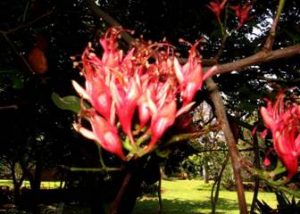
Schotia brachypetala
The genus Schotia was named by Baron Nikolaus von Jacquin, a Dutch botanist, after his friend and travelling companion, Richard Van der Schot, who visited South Africa in the 18th century. The specific name brachypetala simply means “short petals” and comes from the Greek and Latin. Looking at the photograph, you may ask why the specific name is “brachypetala; in fact what you see are not petals, they are sepals (calyces and pedicels). The petals themselves are mostly reduced to mere filaments.
The tree can grow to some 20 meters in height in favourable conditions. In Zimbabwe they are mostly half that size or even less. The tree is densely branched and has a rounded crown with a spread of roughly the same size as its height. The bark is rough grey to dark brown. The leaves are compound with 4 to 6 pairs of leaflets, the margins being entire and wavy. The tree is mildly deciduous – in my garden in Bulawayo it is evergreen.
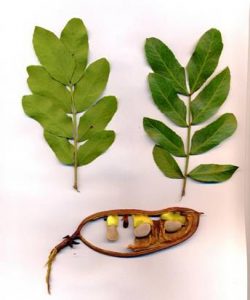
Schotia brachypetala leaves and pod
Flowers are produced from August to November or longer. When in flower the masses of red sepals are spectacular and the nectar attracts many species of birds. I remember spending hours watching different sunbirds: malachite, miombo double-collared, white-bellied, black and marico come to mind. One year we identified over 50 species of birds visiting the tree.
The pods mature around February to May and are woody and dark brown. The pale brown beans are about 20mm diameter but have a very characteristic bright yellow aril. The pods split on the tree but when they fall the pod membrane rots rather quickly leaving a rib skeleton.
The seeds minus the aril can be roasted and eaten. Monkeys, parrots and bush-babies also eat the seeds (without roasting). The leaves are browsed by many species of antelopes and giraffes. The black rhino is reputed to eat the bark. The tree also attracts many kinds of insects and is larval food for several species of charaxes butterflies.
Medicinally it is a most important tree as a decoction of the bark is reputed to be just as good as Guronsan to treat hangovers; it is also used as an emetic and to treat diarrhoea Sources: Plantzafrica.com; Van Wyk et al. 1997. Medicinal Plants of South Africa. Briza, Pretoria).
– JP Felu
OUTING TO MACDONALD’S FARM AND GAME PARK, RUWA SUN. APRIL 21, 2013
Sixteen members of the Society assembled outside the gate at MacDonald’s farm, near Ruwa. The usual slight degree of difficulty was encountered with the instructions (the TM sign was not readily visible from the road), but everyone made it in the end.
We then set off in convoy into the small game park. The area consists of Julbernardia globiflora, mnondo, trees, which judging by their uniform size, appeared to be regrowth. Soils were sandy and the altitude was 1510-1530 m, so the area was similar to Cleveland Dam and indeed many other areas we visit near Harare (e.g. Kutsaga, Mukuvisi Woodland etc.). There had obviously been a degree of disturbance in the woodland because there were a number of weedy species, such as black jacks.
The area did not have a very promising appearance, but in fact we found quite a lot of interest. Meg kindly agreed to lead the group and within a few metres of where we parked the cars, we came across some species to discuss.
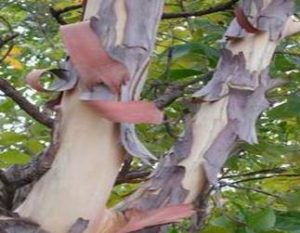
Ochna pulchra, which is known as the Peeling Bark Ochna or the Mermaid’s Tree
One was Ochna pulchra, which is known as the Peeling Bark Ochna or the Mermaid’s Tree. The latter name arises from the rough scaly bark below (see photo) which is replaced by smooth bark above.
Our specimen was rather small and had hardly developed the smooth upper parts yet.
This tree is interesting since it has many medicinal uses, mainly because it is chemo-preventative, i.e. helps prevent diseases. Infusions of the bark and roots are inhibitory against several bacterial diseases and its natural anthranoid compounds have potential against the malaria parasite Plasmodium falciparum. Infusions of the bark are also used to treat burns, swollen legs, stomach problems and diarrhoea, as well as in the treatment of high cholesterol levels.
Also present at the start of our walk was Psorospermum febrifugum, the Christmas berry. Meg showed us the black dots in the leaf lamina. These were concentrated near the apex and the margins. Other species in the Clusiaceae have these black dots e.g. species of Hypericum, the St John’s Worts. However, it was not clear what, if any, function they served. This tree is also under investigation for the active chemical compounds it contains that may be useful in future drug preparations.
A small shrub seen was Grewia decemovulta. This is not really a tree; it is a suffrutex and it was too small to be in Meg’s book. However, it has the typical feature of a Grewia, namely that the leaves are 3-veined from the base and in this case they are also symmetrical at the base and not markedly discolorous.
We then made our way to a termite mound. On the way we passed a beautiful white-flowered shrub. This was Jamesbrittenia albobadia, formerly known as Sutera burkeana. The termite mound as usual displayed a different flora to the surrounding woodland. One tree seen was Coptosperma neurophyllum (formerly known as Tarenna neurophylla). This is a Rubiaceae (Coffee family) and has rather narrow, dark green and glossy leaves and the usual interpetiolar stipules.
Another species from the Coffee family was Vangueria randii, Anthill wild medlar. In this species, the leaves are hairless and the veins appear as very pale and prominent on the underside. During the day we also saw numerous small specimens of Vangueriopsis lanciflora, the False wild medlar, recognisable typically by the brown colours of the stems. Vangueria infausta, usually the commonest species of Vangueria was not seen at all.
Eventually we reached the edge of an extensive vlei. Trees were visible down by the central stream and we headed in to the damp ground to see if we could reach the stream. At the top we encountered a prostrate species of Clematis, flowering on the ground. After some debate it was identified as C. brachiate, Travellers’ Joy. Later, down by the stream we saw it again, in its more usual position, climbing into the trees.
In the vlei were Red hot pokers Kniphofia linearifolia, two yellow flowered Helichrysums H. forskahlii and H. nudifolium, and another yellow-flowered composite which looks like a Helichrysum but actually is not Conyza welwitschii. But perhaps the most attractive flower of all was the Vlei Hedgehog flower, Pycnostachys stuhlmannii, with its extraordinary strong blue coloured flowers. The ground soon got too wet to go any further so we retreated and tried again further along, this time successfully reaching the stream and the groups of trees.
Here were some new species, namely Rhamnus prinoides, Shiny Leaf, Peltophorum africanum, Pavetta gardeniifolia and Tetradenia riparia. Of greater interest was a Rhus with entire leaves which was later identified by Meg and me as Rhus pyroides. We suspect that this is probably overlooked and under recorded. We then all returned for a welcome lunch by the cars.
After lunch, driving back past the farm, I had to get out of the car to open a gate and while doing so noticed a small species of nettle in disturbed ground by the road. It looked like, and subsequently turned out to be, Urtica urens, known as the Small Nettle. It is an annual species from Eurasia and is probably readily spread as a weed. However, there are no records of any species of Urtica from Zimbabwe and this appears to be a first record.
So it was a good end to quite an interesting day. Thanks go to the MacDonalds for allowing us access. The area would repay a further visit at a different time of the year.
– Mark Hyde
MARK HYDE CHAIRMAN


